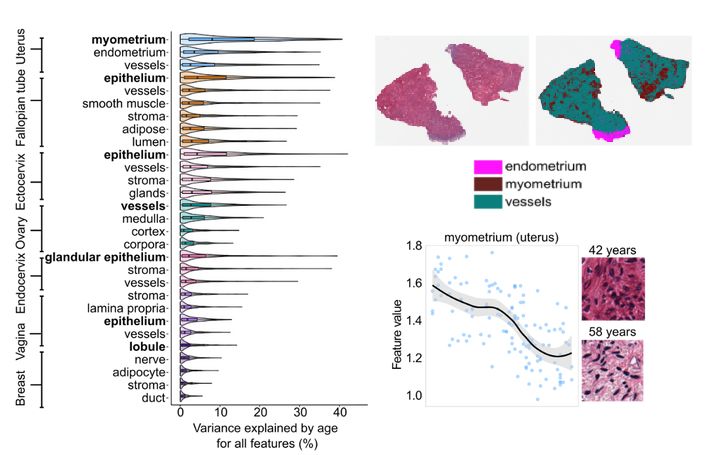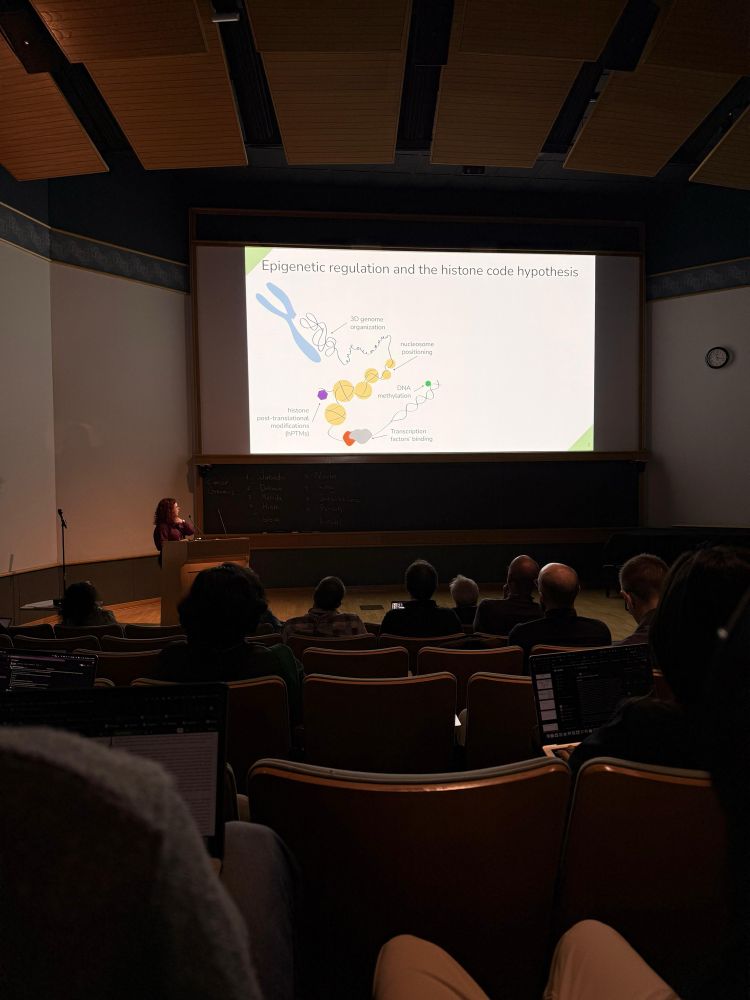Our study reveals that menopause is a biological inflection point that initiates divergent aging trajectories across reproductive tissues.
Aging is asynchronous — and that’s a roadmap to smarter, more targeted interventions.
🔗 www.biorxiv.org/content/10.1...
8/8🧵
23.05.2025 14:19 — 👍 0 🔁 0 💬 0 📌 0

Age-associated genes across uterus, myometrium & ovary overlap with genes from large GWAS or WES studies for:
- Menopause timing
- Age at Menarche
- Pelvic organ prolapse
The uterus isn’t just a passive player—it might hold the keys to predicting and preventing post-menopausal disorders.
7/8🧵
23.05.2025 14:19 — 👍 0 🔁 0 💬 1 📌 0

💡 Bulk RNA-seq isn’t tissue-specific.
But paired with histology, it can be.
We uncovered tissue-specific aging pathways:
🔻 Myometrium: ↓ ECM & muscle genes
🔺 Vaginal epithelium: ↓ epithelial +↑ immune genes
🔻 Ovarian cortex: ↓ angiogenesis
Organs don’t age as one.
6/8 🧵
23.05.2025 14:19 — 👍 0 🔁 0 💬 1 📌 0

The vaginal epithelium showed a menopause-timed crash in thickness.
This is more than known thinning: we saw extensive histological remodeling and sharp trajectory shifts at ~51 yrs.
❗Histology beats gene expression at capturing this transition.
5/8🧵
23.05.2025 14:19 — 👍 0 🔁 0 💬 1 📌 0

We zoomed in further.
Segmenting tissues with a vision transformer revealed that the myometrium (uterine muscle) is the most age-sensitive tissue.
Its histology transforms —collagen builds up, structure changes— with aging.
4/8🧵
23.05.2025 14:19 — 👍 0 🔁 0 💬 1 📌 0

Using CNNs, we trained aging classifiers per organ. Result?
📈 Ovaries & vagina show gradual aging
⚡️ Uterus shows abrupt transition around age 51—right at menopause!
Transcriptomic data mirrored this: gene expression shifts sharply in the uterus but not in the ovary or vagina.
3/8🧵
23.05.2025 14:19 — 👍 0 🔁 0 💬 1 📌 0

We combined:
🖼️ 1,112 histological images
🧬 659 RNA-seq samples
🧠 Deep learning + vision transformers
📊 Multi-omics integration
All from 304 women aged 20-70 (GTEx dataset).
Across 7 organs: uterus, ovary, vagina, breast, ectocervix, fallopian tubes, and endocervix.
2/8🧵
23.05.2025 14:19 — 👍 1 🔁 0 💬 1 📌 0
📢Menopause affects half the population — yet it's been one of the most overlooked areas in aging research.
We found that aging in the female reproductive system unfolds in unexpected, organ-specific ways. 🔗 www.biorxiv.org/content/10.1...
1/8🧵
23.05.2025 14:19 — 👍 9 🔁 3 💬 1 📌 2


Our lab had dual presence at #BoG25 @cshlmeetings.bsky.social!
🧬 Silvia González-López spoke on chromatin dynamics & transcriptional regulation.
🌍 @fairlie.bsky.social presented ancestry-aware gene annotations — a @guigolab.bsky.social × @melelab.bsky.social collab:
www.biorxiv.org/content/10.1...
14.05.2025 07:46 — 👍 7 🔁 3 💬 0 📌 0

The impact of sex, age, and genetic ancestry on DNA methylation across tissues
Background: Understanding the consequences of individual DNA methylation variation is crucial for the study of human biology and disease. However, the collective impact of demographic traits on DNA me...
Excited to share our new preprint: The impact of sex, age, and genetic ancestry on DNA methylation across tissues. Briefly, we explored how sex, age, and genetic ancestry shape DNA methylation across tissues and individuals. Want to know a bit more? Follow this “bluetorial”!
doi.org/10.1101/2025...
05.05.2025 15:44 — 👍 11 🔁 5 💬 1 📌 1
We want to thank everyone 👩🔬 involved in this work: @pclavell.bsky.social, @fairlie.bsky.social, @scarbonells.bsky.social, @fdegalez.bsky.social, Carme Arnan, @oliveroswinona.bsky.social, @rodericguigo.bsky.social, @martamele.bsky.social as well as the institutions: @bsc-cns.bsky.social, @crg.eu ✨
20.03.2025 13:20 — 👍 8 🔁 1 💬 1 📌 1

Long-read transcriptomics of a diverse human cohort reveals widespread ancestry bias in gene annotation
Accurate gene annotations are fundamental for interpreting genetic variation, cellular function, and disease mechanisms. However, current human gene annotations are largely derived from transcriptomic...
🟢Overall, our work suggests that to overcome gene annotation ancestry biases we require:
🥇long-read sequencing of transcriptomes from diverse human populations
🥈the development of transcript discovery tools for the pangenome @humanpangenome.bsky.social to bypass reference biases
Preprint ⬇️⬇️⬇️
13
20.03.2025 13:20 — 👍 5 🔁 1 💬 1 📌 0

🔴We saw that 🧬👤 full personal genome assemblies:
1️⃣ enable the discovery of novel transcripts that can not be found with GRCh38
2️⃣ contain regions not found in GRCh38 that harbor potentially novel genes (albeit at very low densities compared to the rest of the genome)
12
20.03.2025 13:20 — 👍 2 🔁 0 💬 1 📌 0
🔴This shows that the genome assembly of choice can potentially hide 🙈 transcripts due to genetic diversity.
To further explore the impact of *ALL* genetic diversity on transcript discovery, we did similar analyses comparing GRCh38 with 🧬👤 full personal genome assemblies ⬇️
11
20.03.2025 13:20 — 👍 2 🔁 0 💬 1 📌 0

💥We find that personalized-GRCh38s enable the discovery of >3% more novel transcripts than using GRCh38.
🌍More importantly, this increase is uneven between populations, with African individuals benefiting most (LWK, YRI).
10
20.03.2025 13:20 — 👍 3 🔁 0 💬 1 📌 0
💡Our hypothesis was that genetic variants differing from the reference genome sequence could interfere in the transcript discovery process.
So we compared transcript discovery when using GRCh38 and modified (👤personalized) versions of GRCh38 containing each sample's SNPs ⬇️
9
20.03.2025 13:20 — 👍 2 🔁 0 💬 1 📌 0
So far, we’ve shown that reference gene annotations are European biased ✅
❓However, would it be enough to sequence RNA from genetically diverse cohorts to build truly representative gene annotations?
So we searched 🔎 for potential biases caused by using reference genome assemblies (GRCh38) ⬇️
8
20.03.2025 13:20 — 👍 2 🔁 0 💬 1 📌 0

This is precisely what happens when linking 🧬 genetic variation to 📈 transcript expression ⬇️
🔴We show that a population-diverse gene annotation increases the discovery of associations between SNPs and transcript expression, especially in non-European populations 🌍
7
20.03.2025 13:20 — 👍 3 🔁 0 💬 1 📌 0
❓Why is this important?
Gene annotations enable the interpretation of the human genome sequence by providing context on how the molecular actors (RNA/proteins) play a role to produce different phenotypes.
➡️If gene annotations are biased, so too might be our interpretation of the genome
6
20.03.2025 13:20 — 👍 2 🔁 0 💬 1 📌 0
➡️This is a direct consequence of the systematic underrepresentation of non-European samples 🌍 throughout the -omics fields.
🔴In other words, the data used to build current gene annotations is not representative of global human genetic diversity.
5
20.03.2025 13:20 — 👍 2 🔁 0 💬 1 📌 0
In all samples, we found many transcripts that have never been seen before (~40k total) 👀
❗Interestingly, we find more novel transcripts in non-European ancestry samples than in European ones.
🔴This means that gene annotations systematically miss more transcripts from non-European individuals.
4
20.03.2025 13:20 — 👍 2 🔁 0 💬 1 📌 0

Together with @guigolab.bsky.social 🙌 we deeply sequenced RNA of 43 cell lines (LCL) 🧫 from 8 human populations 👥with distinct genetic ancestries 🌍 using ONT (@nanoporetech.com) to capture full-length mRNA and lncRNA molecules.
3
20.03.2025 13:20 — 👍 2 🔁 0 💬 1 📌 0
⚠️Most transcriptomic data comes from European-descent individuals; implying that data used to build gene annotations does too. Furthermore, there are no long-read transcriptomic datasets that sample 🌍 diverse human populations
❓We wondered if this could bias reference gene annotations
2
20.03.2025 13:20 — 👍 2 🔁 0 💬 1 📌 0

Long-read transcriptomics of a diverse human cohort reveals widespread ancestry bias in gene annotation
Accurate gene annotations are fundamental for interpreting genetic variation, cellular function, and disease mechanisms. However, current human gene annotations are largely derived from transcriptomic...
Do you work in 💫human genetics💫?
Have you ever worried about what’s inside your gene annotation GTF⁉️
WELL, YOU SHOULD! 😱
Especially when studying a genetically diverse 🌍 cohort!
🔴We discover that gene annotations are European-biased 👉 impacting downstream analyses!
Don't miss this thread🧵⬇️
1/13
20.03.2025 13:20 — 👍 30 🔁 13 💬 3 📌 8
Really interesting talk by our talented PhD student @mariasopenarios.bsky.social at #WomensHealth2025 conference!
07.02.2025 12:15 — 👍 3 🔁 0 💬 0 📌 0
AMAZING JOB by our postdoc Oleksandra presenting her results at #WomensHealth2025
04.02.2025 13:55 — 👍 3 🔁 0 💬 0 📌 0
Sabeti lab PostDoc @ Broad Institute of MIT an Harvard
genetics, compbio, & viruses
www.lauraluebbert.com
Independent Junior Group Leader at TUM - Postdoc in the Rinn & Meissner Lab (Harvard) - PhD in Denise Barlow's lab (CeMM)
Pediatrician &
Professor of Pediatric Immunology
Human Systems Immunology
MRC LMS, Imperial College London
& Karolinska Institutet
🇸🇪 Systems Immunology group leader @lunduniversity | Sex differences in Human Immunity | 🇸🇪 MSCA postdoc | 🇺🇸 PhD | 🇧🇷 BS & MSc | she/her
Professor of Human Genetics, interested in reproductive genomics, women’s health, menopause.
Computer scientist at I2SysBio-CSIC. Transcriptomics, long-reads, multiomics, tool developer. Promoter of Green Science. Finally happy!
PI of the machine learning for Integrative genomics lab @pasteur.fr and @CNRS.bsky.social
#NewPI #DiversityEqualityInclusion
Single-cell, multi-omics, machine learning
International research centre devoted to curing #cancer and other diseases linked to #aging. @cerca.cat center, member of @bist.eu.
www.irbbarcelona.org
Un ecosistema publicoprivat capdavanter que promou la #recerca de excel·lència, la #tranferència de #coneixement, la #emprenedoria i la #innovació en #ciènciesdelavida i la #salut | #PCBCommunity #UniBarcelona
🌐 www.pcb.ub.edu
Neuro-onco-immunology: Postdoc at Dixon Lab @unibas.ch
Contributing to: @openboxscience.bsky.social
Bone marrow donor. First-gen student.
https://orcid.org/my-orcid?orcid=0000-0002-9821-1396
https://www.linkedin.com/in/annasalameroboix/
Research Manager at BSC_CNS
“The world is my country, science is my religion.”
Never ending apprentice of data illusionist, scientific software infrastructures and reproducibility and other (maybe useless) skills.
ORCID: 0000-0002-4806-5140
Modelling, systems biology at Computational Biology BSC-CNS
Postdoc in @melelab | Barcelona Supercomputing Center | Image analysis 🌌 & transcriptomics 🧬| Women’s health 💃 |Cognitive neuroscience in ❤️ |
Ukraine will win 🌻
Research group at the @geneticsub.bsky.social
of the UB (@ub.edu). With @jrozasub.bsky.social, @riutortlab.bsky.social, A. Sánchez-Gracia, @mariottilab.bsky.social, J. Lozano and S. Guirao-Rico.
https://www.ub.edu/molevol/MEG
Professor of Genetics at the Universitat de Barcelona (@ub.edu). Interested in Evolutionary Biology, Population Genomics and Bioinformatics
Postdoctoral Researcher at @JavierreLab. Bioinformatician & biochemist. Love to code, cook and bake!
Postdoctoral Researcher at Scheiffele Lab
Biozentrum University of Basel 🇨🇭
RNA, evolution and neurobiology
Associate professor at Universitat de Barcelona.
Studying post transcriptional regulation in single cells and Alzheimer's Disease. iPSCs, gene regulatory networks, bioinformatics, systems biology
https://www.plasslab.com/













